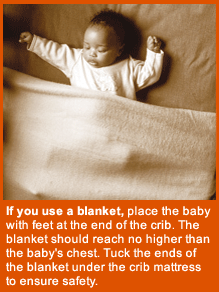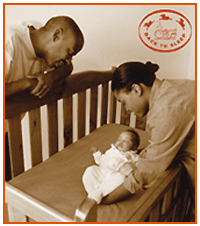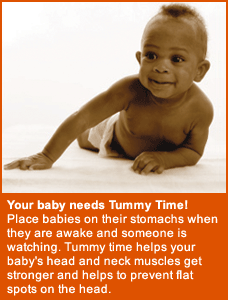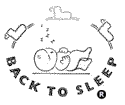SIDS: "Back to Sleep" Campaign
Safe Sleep for Your Baby: Reduce the Risk of Sudden Infant Death Syndrome (SIDS) (African American Outreach)

Contents
What is SIDS?
SIDS stands for sudden infant death syndrome. This term describes the sudden, unexplained death of an infant younger than 1 year of age.
Some people call SIDS "crib death" because many babies who die of SIDS are found in their cribs. But, cribs don't cause SIDS.
What should I know about SIDS? Health care providers don't know exactly what causes SIDS, but they do know: - Babies sleep safer on their backs. Babies who sleep on their stomachs are much more likely to die of SIDS than babies who sleep on their backs.
- Sleep surface matters. Babies who sleep on or under soft bedding are more likely to die of SIDS.
- Every sleep time counts. Babies who usually sleep on their backs but who are then placed on their stomachs, like for a nap, are at very high risk for SIDS. So it's important for everyone who cares for your baby to use the back sleep position for naps and at night.
- Communities across the nation have made great progress in reducing SIDS! Since the Back to Sleep campaign began in 1994, the SIDS rate among African Americans has declined by nearly 50 percent.
|
Fast Facts About SIDS - SIDS is the leading cause of death in infants between 1 month and 1 year of age.
- Most SIDS deaths happen when babies are between 2 months and 4 months of age.
- African American babies are more than 2 times as likely to die of SIDS as white babies.
|
|
|
What can I do to lower my baby's risk of SIDS?
Here are 10 ways that you and others who care for your baby can reduce the risk of SIDS.
Safe Sleep Top 10
- Always place your baby on his or her back to sleep, for naps and at night. The back sleep position is the safest, and every sleep time counts.
- Place your baby on a firm sleep surface, such as on a safety-approved* crib mattress, covered by a fitted sheet. Never place your baby to sleep on pillows, quilts, sheepskins, and other soft surfaces.
 Keep soft objects, toys, and loose bedding out of your baby's sleep area. Don't use pillows, blankets, quilts, sheepskins, and pillow-like crib bumpers in your baby's sleep area, and keep any other items away from your baby's face.
Keep soft objects, toys, and loose bedding out of your baby's sleep area. Don't use pillows, blankets, quilts, sheepskins, and pillow-like crib bumpers in your baby's sleep area, and keep any other items away from your baby's face.
- Do not allow smoking around your baby. Don't smoke before or after the birth of your baby, and don't let others smoke around your baby.
- Keep your baby's sleep area close to, but separate from, where you and others sleep. Your baby should not sleep in a bed or on a couch or armchair with adults or other children, but he or she can sleep in the same room as you. If you bring your baby in bed with you to breastfeed, put him or her back in a separate sleep area, such as a bassinet, crib, cradle, or a bedside cosleeper (infant bed that attaches to an adult bed) when finished.
 Think about using a clean, dry pacifier when placing the infant down to sleep, but don't force the baby to take it. (If you are breastfeeding your baby, wait until your child is 1 month old or is used to breastfeeding before using a pacifier.)
Think about using a clean, dry pacifier when placing the infant down to sleep, but don't force the baby to take it. (If you are breastfeeding your baby, wait until your child is 1 month old or is used to breastfeeding before using a pacifier.)
- Do not let your baby overheat during sleep. Dress your baby in light sleep clothing, and keep the room at a temperature that is comfortable for an adult.
- Avoid products that claim to reduce the risk of SIDS because most have not been tested for effectiveness or safety.
- Do not use home monitors to reduce the risk of SIDS. If you have questions about using monitors for other conditions talk to your health care provider.
 Reduce the chance that flat spots will develop on your baby's head: provide "Tummy Time" when your baby is awake and someone is watching; change the direction that your baby lies in the crib from one week to the next; and avoid too much time in car seats, carriers, and bouncers.
Reduce the chance that flat spots will develop on your baby's head: provide "Tummy Time" when your baby is awake and someone is watching; change the direction that your baby lies in the crib from one week to the next; and avoid too much time in car seats, carriers, and bouncers.
*For more information on crib safety, contact the Consumer Product Safety Commission at 1-800-638-2772 or at http://www.cpsc.gov
Babies sleep safest on their backs.
One of the easiest ways to lower your baby's risk of SIDS is to put him or her on the back to sleep, for naps and at night. Health care providers used to think that babies should sleep on their stomachs, but research now shows that babies are less likely to die of SIDS when they sleep on their backs. Placing your baby on his or her back to sleep is the number one way to reduce the risk of SIDS.
But won't my baby choke if he or she sleeps on his or her back?
No. Healthy babies automatically swallow or cough up fluids. There has been no increase in choking or other problems for babies who sleep on their backs.
Spread the word!
Make sure everyone who cares for your baby knows the Safe Sleep Top 10! Tell grandparents, babysitters, childcare providers, and other caregivers to always place your baby on his or her back to sleep to reduce the risk of SIDS. Babies who usually sleep on their backs but who are then placed on their stomachs, even for a nap, are at very high risk for SIDS—so every sleep time counts!

| For more information on sleep position
for babies and reducing the risk of SIDS,
contact the Back to Sleep campaign at:
1-800-505-CRIB
31 Center Drive, Room 2A32
Bethesda, MD 20892-2425
Fax: (301) 496-7101
Web site: www.nichd.nih.gov
|
Back to Sleep campaign sponsors include:
Eunice Kennedy Shriver National Institute of Child Health and Human Development
Maternal and Child Health Bureau
American Academy of Pediatrics • SIDS Alliance
Association of SIDS and Infant Mortality Programs |
 | Eunice Kennedy Shriver National Institute of Child Health and Human Development
October 2005
NIH Pub No. 05-5355 |
Partners in this outreach include:
Alpha Kappa Alpha Sorority • Chi Eta Phi Sorority
Chicago Department of Public Health
Congress of National Black Churches
District of Columbia Department of Health
National Association for the Advancement of Colored People
National Black Child Development Institute
National Coalition of 100 Black Women
National Medical Association
National Association of Black Owned Broadcasters
Pampers Parenting Institute • Zeta Phi Beta Sorority
 | U.S. Department of Health and
Human Services
Public Health Service
National Institutes of Health |  |
Top